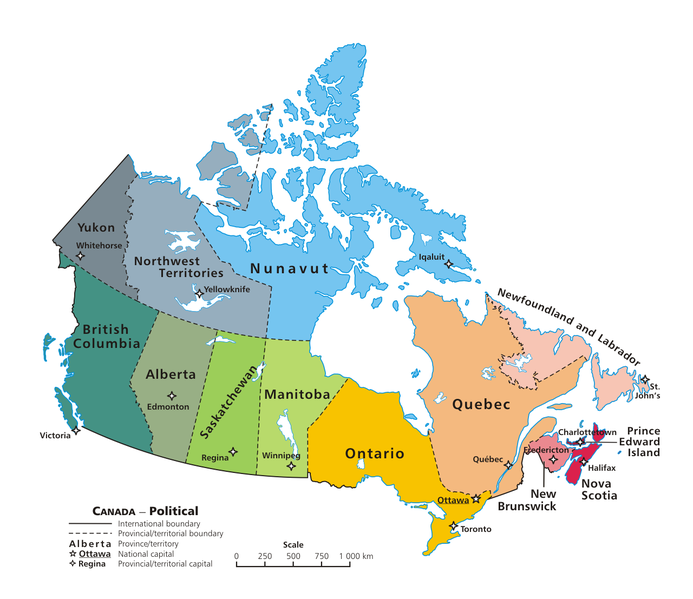Q35. Canadian map explain from Immigration’s prospect.
Ontario:

Ontario is Canada's most populous province and a major destination for immigrants. In 2024, Ontario received over 200,000 permanent visas, accounting for nearly 50% of Canada's total immigration intake.
Ontario is home to the country's financial and business hub, Toronto, as well as a thriving technology sector in the Kitchener-Waterloo region. The province offers diverse employment opportunities in finance, technology, manufacturing, and the service industry.
Ontario's multicultural cities, excellent education system, and high quality of life make it an attractive destination for immigrants seeking career growth and a welcoming environment to settle.
Quebec:
Quebec is the second-largest recipient of immigrants in Canada, with over 80,000 permanent visas allocated in 2024, representing around 20% of the national total.
The province is known for its unique French-Canadian culture, vibrant cities like Montreal, and a strong manufacturing and aerospace industry. Quebec also has a thriving tourism sector and a growing tech industry.
Quebec offers immigrants the opportunity to immerse themselves in a distinct cultural experience while benefiting from a high standard of living, affordable housing, and a welcoming community.
British Columbia:
British Columbia (BC) received around 60,000 permanent visas in 2024, accounting for approximately 15% of Canada's total immigration intake.
BC is renowned for its natural beauty, with the bustling city of Vancouver and the stunning landscapes of the Rocky Mountains. The province has a diverse economy, with strengths in technology, film and television, agriculture, and resource-based industries.
Immigrants to BC can enjoy a high quality of life, access to outdoor recreation, and a thriving multicultural environment in cities like Vancouver and Victoria.
Alberta:
Alberta received around 40,000 permanent visas in 2024, making up about 10% of Canada's immigration numbers.
The province is a hub for the energy industry, with a strong oil and gas sector, as well as a growing technology and agriculture industry. Alberta offers well-paid jobs in fields like engineering, technology, and skilled trades.
Immigrants to Alberta can benefit from a relatively low cost of living, affordable housing, and a family-friendly atmosphere, particularly in cities like Calgary and Edmonton.
Manitoba:
Manitoba received around 15,000 permanent visas in 2024, accounting for approximately 4% of Canada's total immigration intake.
The province has a diverse economy, with strengths in agriculture, manufacturing, and the service sector. Winnipeg, the capital city, is a hub for finance, transportation, and the aerospace industry.
Manitoba offers immigrants a lower cost of living, a welcoming community, and opportunities to build careers in various industries, including agriculture, manufacturing, and the service sector.
Saskatchewan:
Saskatchewan received around 10,000 permanent visas in 2024, representing about 2.5% of Canada's immigration numbers.
The province is known for its strong agricultural and resource-based industries, including potash, uranium, and oil and gas. Saskatchewan also has a growing technology and renewable energy sector.
Immigrants to Saskatchewan can benefit from a lower cost of living, affordable housing, and a high quality of life, particularly in cities like Saskatoon and Regina.
Atlantic Provinces (Nova Scotia, New Brunswick, Prince Edward Island, Newfoundland and Labrador):
The Atlantic provinces collectively received around 20,000 permanent visas in 2024, accounting for approximately 5% of Canada's total immigration intake.
These provinces offer a unique East Coast lifestyle, with a focus on maritime industries, tourism, and emerging sectors like ocean technology and renewable energy.
Immigrants to the Atlantic provinces can enjoy a slower pace of life, a lower cost of living, and a welcoming community, while exploring opportunities in industries like fishing, aquaculture, and the growing technology and renewable energy sectors.
Territories (Yukon, Northwest Territories, Nunavut):
The three territories in northern Canada (Yukon, Northwest Territories, and Nunavut) collectively received around 5,000 permanent visas in 2024, representing about 1.25% of Canada's total immigration intake.
These regions are known for their vast wilderness, indigenous cultures, and resource-based industries like mining, oil and gas, and tourism.
Immigrants to the territories can experience a unique northern lifestyle, access to outdoor recreation, and opportunities to work in industries like mining, energy, and tourism, while contributing to the development of these remote regions.
In summary, Canada's provinces and territories offer a diverse range of opportunities for immigrants, from the bustling cities of Ontario and Quebec to the natural wonders and resource-based industries of the western and northern regions. Each location presents unique benefits, from career prospects and cultural experiences to affordable living and high quality of life, making Canada an attractive destination for prospective immigrants.

